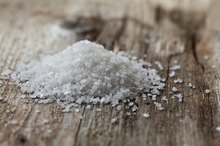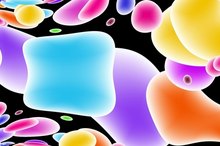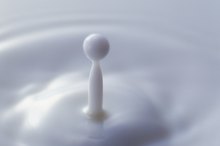Bicarbonate of Soda Vs. Sodium Chloride
Both bicarbonate of soda -- often called baking soda -- and sodium chloride are chemical salts. This means they're each made up of individual charged particles called ions. While they share some similar chemical properties, they also differ significantly in their behavior in the human body and in chemical reactions.
Bicarbonate of Soda Chemistry
Bicarbonate of soda is much more commonly called sodium bicarbonate, or simply baking soda. It has the chemical formula NaHCO3, and consists of two separate charged particles -- a positively charged Na or sodium particle, and a negatively charged HCO3 or bicarbonate particle. In solid form, these two particles stick together. In solution, however, such as in the bloodstream, the particles separate from one another and engage in different chemical reactions.
- Bicarbonate of soda is much more commonly called sodium bicarbonate, or simply baking soda.
- In solution, however, such as in the bloodstream, the particles separate from one another and engage in different chemical reactions.
Sodium Chloride Chemistry
How Does Sodium Bicarbonate Affect Blood pH Levels?
Learn More
Like sodium bicarbonate, sodium chloride is a salt made up of two charged particles. In the case of sodium chloride, the two particles are a positively charged sodium, or Na, and a negatively charged chloride, or Cl. This gives sodium chloride the chemical formula NaCl. Also like sodium bicarbonate, the charged particles stick together when the salt is a solid, and separate from one another when the salt dissolves in liquid. Sodium chloride is more commonly called table salt.
- Like sodium bicarbonate, sodium chloride is a salt made up of two charged particles.
- In the case of sodium chloride, the two particles are a positively charged sodium, or Na, and a negatively charged chloride, or Cl.
Acidity
One of the major differences between sodium chloride and sodium bicarbonate is sodium chloride is neither acidic nor basic, while sodium bicarbonate is both. At acidity levels similar to those found in the human body, however, sodium bicarbonate functions almost exclusively as a base, meaning it reacts chemically with acids. Drs. Reginald Garrett and Charles Grisham, in their book "Biochemistry," note bicarbonate is best classified as a weak physiological base 1.
- One of the major differences between sodium chloride and sodium bicarbonate is sodium chloride is neither acidic nor basic, while sodium bicarbonate is both.
- At acidity levels similar to those found in the human body, however, sodium bicarbonate functions almost exclusively as a base, meaning it reacts chemically with acids.
Use In Food
Sodium Chloride and Digestion
Learn More
Humans commonly use both sodium chloride and sodium bicarbonate in cooking, though the chemicals serve different purposes. The flavor of sodium chloride is one most people find pleasing, so it's common to season food with table salt. Table salt participates in virtually no chemical reactions in food -- it's merely a flavoring agent. Sodium bicarbonate doesn't have a pleasing flavor, but it reacts with acid in food to produce carbon dioxide, which makes baked goods rise. As such, baking soda is a common leavening agent.
- Humans commonly use both sodium chloride and sodium bicarbonate in cooking, though the chemicals serve different purposes.
- The flavor of sodium chloride is one most people find pleasing, so it's common to season food with table salt.
Location In The Body
You have both sodium chloride and sodium bicarbonate in your body. Your blood contains sodium bicarbonate, which helps you to maintain a constant acidity level, explains Dr. Lauralee Sherwood in her book "Human Physiology." Your pancreas also produces sodium bicarbonate to react with stomach acid as the stomach empties into the pancreas 2. Your blood contains sodium chloride to help with fluid balance, and nerve cells also rely upon the components of sodium chloride to send chemical signals.
- You have both sodium chloride and sodium bicarbonate in your body.
- Your blood contains sodium chloride to help with fluid balance, and nerve cells also rely upon the components of sodium chloride to send chemical signals.
Related Articles
References
- “Biochemistry”; Reginald Garrett, Ph.D. and Charles Grisham, Ph.D.; 2007
- “Human Physiology”; Lauralee Sherwood, Ph.D.; 2004
- American Heart Association. Sources of Sodium.
- Centers for Disease Control and Prevention. Top 10 Sources of Sodium. 2017.
- Institute of Medicine. Dietary Reference Intakes Tables and Application. National Academies of Sciences, Engineering, and Medicine, Health and Medicine Division. 2015.
- United States Department of Agriculture. Dietary Guidelines for Americans 2015–2020. United States Department of Health and Human Services. 2015.
Writer Bio
Kirstin Hendrickson is a writer, teacher, coach, athlete and author of the textbook "Chemistry In The World." She's been teaching and writing about health, wellness and nutrition for more than 10 years. She has a Bachelor of Science in zoology, a Bachelor of Science in psychology, a Master of Science in chemistry and a doctoral degree in bioorganic chemistry.









